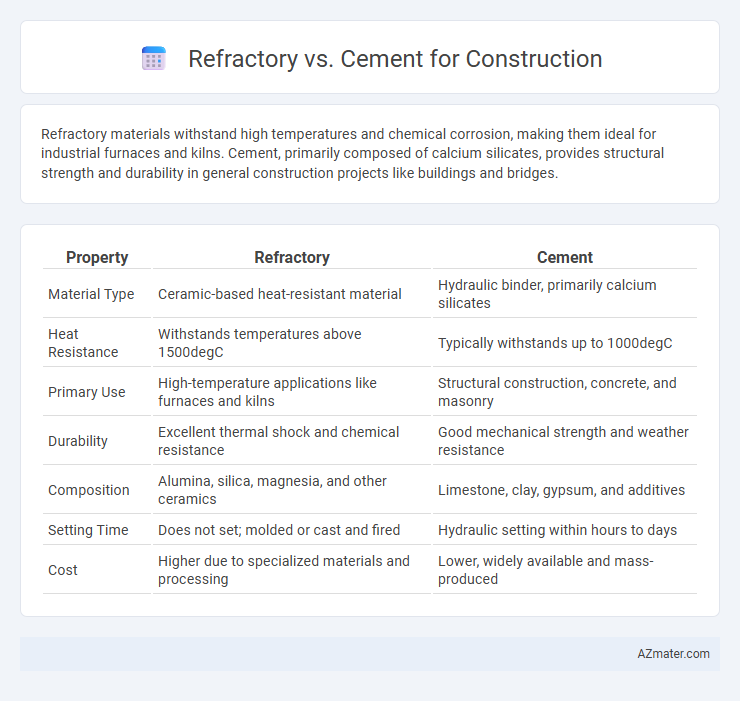Refractory materials withstand high temperatures and chemical corrosion, making them ideal for industrial furnaces and kilns. Cement, primarily composed of calcium silicates, provides structural strength and durability in general construction projects like buildings and bridges.
Table of Comparison
| Property | Refractory | Cement |
|---|---|---|
| Material Type | Ceramic-based heat-resistant material | Hydraulic binder, primarily calcium silicates |
| Heat Resistance | Withstands temperatures above 1500degC | Typically withstands up to 1000degC |
| Primary Use | High-temperature applications like furnaces and kilns | Structural construction, concrete, and masonry |
| Durability | Excellent thermal shock and chemical resistance | Good mechanical strength and weather resistance |
| Composition | Alumina, silica, magnesia, and other ceramics | Limestone, clay, gypsum, and additives |
| Setting Time | Does not set; molded or cast and fired | Hydraulic setting within hours to days |
| Cost | Higher due to specialized materials and processing | Lower, widely available and mass-produced |
Understanding Refractory and Cement: Key Differences
Refractory materials are specialized substances designed to withstand extremely high temperatures and harsh conditions, making them ideal for furnace linings and kilns. Cement, by contrast, serves as a binding agent in construction, providing structural integrity by hardening and setting when mixed with water and aggregates. The primary difference lies in thermal resistance and application: refractories offer heat insulation and durability under thermal stress, while cement ensures strength and stability in general building structures.
Composition and Material Properties
Refractory materials consist primarily of fireclay, alumina, silica, and various oxides designed to withstand extreme temperatures exceeding 1500degC, making them ideal for furnaces, kilns, and reactors. Cement, mainly composed of clinker minerals like calcium silicates and gypsum, exhibits high compressive strength and sets through hydration but lacks thermal resistance beyond 400degC. The fundamental distinction lies in their thermal stability and chemical composition, with refractory materials engineered for heat retention and structural integrity under thermal stress, whereas cement provides mechanical bonding and load-bearing capacity in conventional construction.
Typical Applications in Construction
Refractory materials are designed to withstand extremely high temperatures and are typically used in furnace linings, kiln construction, and incinerators where heat resistance is critical. Cement, particularly Portland cement, serves as a versatile binding agent in concrete and mortar, commonly applied in foundations, structural frameworks, and pavements for general construction projects. While refractory materials enhance durability under thermal stress, cement provides essential structural integrity and bonding in a wide range of construction environments.
Thermal Resistance: How They Compare
Refractory materials are engineered to withstand extreme temperatures exceeding 1,500degC, providing superior thermal resistance compared to conventional cement, which typically endures temperatures up to 650degC before degrading. The high alumina and silica content in refractory bricks enables them to maintain structural integrity and insulation under intense heat, crucial for furnaces, kilns, and industrial applications. Cement, while cost-effective for general construction, lacks the thermal stability required for high-temperature environments, making refractory materials the preferred choice for thermal insulation and heat protection in severe conditions.
Mechanical Strength and Durability
Refractory materials exhibit superior mechanical strength and durability compared to conventional cement, making them ideal for high-temperature and chemically aggressive environments in construction. Their composition, often including alumina, silica, and fireclay, enhances resistance to thermal shock and abrasion, significantly extending the lifespan of structures such as furnaces and kilns. Conventional cement, while durable under normal conditions, tends to degrade faster under extreme heat and mechanical stress, limiting its effectiveness in specialized industrial applications.
Installation Methods and Techniques
Refractory materials require precise installation techniques such as casting, gunning, or ramming to withstand high temperatures in industrial applications, often involving skilled labor for proper curing and drying. Cement installation involves mixing, pouring, and curing, emphasizing moisture control and surface preparation for structural integrity in general construction projects. Both demand adherence to manufacturer guidelines and environmental conditions to ensure long-term durability and performance.
Cost Considerations: Budgeting for Your Project
Refractory materials typically incur higher costs than standard cement due to their specialized heat-resistant properties essential for industrial applications. Budgeting must account for long-term durability and maintenance savings, as refractory materials reduce replacement frequency in high-temperature environments. Cement offers a cost-effective solution for general construction, but projects demanding thermal resistance will benefit from investing in refractory for enhanced performance and safety.
Lifespan and Maintenance Requirements
Refractory materials used in construction offer superior lifespan and durability under extreme temperatures compared to cement, which is more prone to cracking and degradation over time. Maintenance requirements for refractory installations are generally lower, as these materials resist thermal stress and chemical attack, reducing the frequency of repairs. Cement structures demand regular inspection and maintenance due to their susceptibility to weathering, moisture infiltration, and thermal cycling.
Environmental Impact and Sustainability
Refractory materials typically have higher energy consumption and carbon emissions during manufacturing compared to conventional cement due to their specialized composition and production processes. Cement production contributes significantly to global CO2 emissions, approximately 8% worldwide, but innovations in low-carbon cements and carbon capture technologies aim to reduce this environmental impact. Sustainable construction increasingly favors materials with lower embodied energy, recyclability, and enhanced durability, positioning advanced eco-friendly cement alternatives as preferable over traditional refractory in reducing long-term environmental footprint.
Choosing the Right Material for Your Construction Needs
Refractory materials offer superior heat resistance and durability, making them ideal for high-temperature applications such as furnaces, kilns, and fireplaces, whereas cement is more suitable for general construction due to its strength and versatility in structural projects. Selecting the right material depends on the specific thermal demands and mechanical performance required by the construction environment, with refractory materials excelling in industrial settings and cement preferred for buildings and infrastructure. Understanding the thermal conductivity, compressive strength, and chemical resistance of each material ensures optimal performance and longevity in your construction project.

Infographic: Refractory vs Cement for Construction
 azmater.com
azmater.com